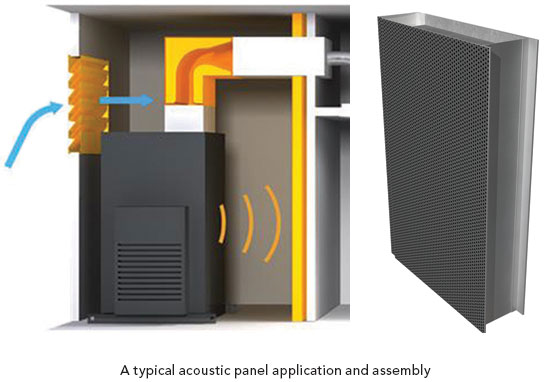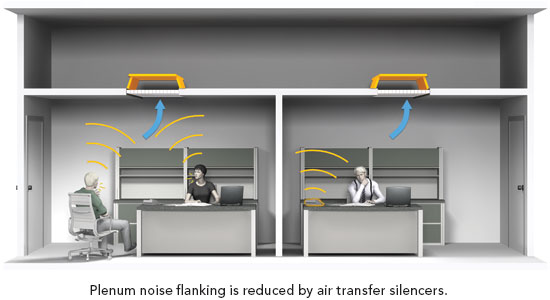Silence Is Golden
Three Aspects of Noise
Noise can be thought of in three distinct aspects—source, path, and receiver. Every project has these three aspects, though they vary in number (one source vs. many) and importance (the receiver is an intern vs. the CEO). In many cases, noise control products can be applied to improve various conditions. Each project is unique with varying limitations such as budget or space. Understanding project parameters and available noise control products allows for the most effective design solution. The illustration above depicts some common noise conditions in a typical office setting and products to address them. Blue arrows indicate air flow and yellow waves indicate noise. The noise control products in yellow are often referred to as air transfer silencers and are discussed later.
Sound Transmission
Idealized lab-rated sound transmission loss is often described using STC (Sound Transmission Class), a lab measurement of the noise reduction provided by a building assembly. Examples of typical building assemblies with STC ratings include walls, ceiling, and floors. Other sound transmission field measurements are ASTC (Apparent Sound Transmission Class) and NIC (Noise Isolation Class) depending on field conditions. These field measured ratings are typically five points lower than the corresponding lab rating because of flanking paths such as cracks and holes (piping penetrations, mullion conditions, etc). The table below simplifies the description for common noise change perception, whether from a sound source or building assembly's noise isolation performance. To be clear, STC points and dB are not equivalent, but for the sake of simplicity and perception they are used interchangeably in this discussion.

Image courtesy of Price Industries
Noise control products address various conditions.
Field construction quality impacts drywall partition performance; often the joints are not properly finished, which decreases overall noise isolation. Over time, a partition's noise isolation performance may deteriorate. For example, if the caulk sealing a joint dries out, cracks can allow for noise to flank between spaces. Common elements such as light switches and electrical outlets also reduce noise isolation performance, since they're not always sealed completely and the plastic assemblies have lower mass than the drywall that was removed. Ultimately, field noise isolation provided by poor construction can vary from equivalent laboratory STC by more than 15. Operable partitions are even worse when comparing lab and field noise isolation ratings; the spread is often in excess of 10 due to flanking paths, improper installation, and operable wall size.
Several guidelines to optimize a wall construction's acoustic performance in the field include using two layers of overlapping drywall on each side of the stud between noise-sensitive spaces, selecting lighter-gauge metal channel studs, staggering electrical outlets and switches so they are not in the same stud space, filling stud cavities with sound-absorbing material, and sealing all joints and penetrations completely using non-hardening caulk. Just adding 2 inches of sound-absorbing material in a stud cavity for example can improve STC performance by at least 2 to 5 depending on the overall wall construction. One of the easiest methods to identify noise leaks is to perform a light test. Turn the lights off on one side of a building assembly and look for light leaking in on the dark side. Wherever there is light, there is the potential for noise to leak. Unfortunately if you're afraid of the dark, this is a horrible method.

Source: Price Industries
Noise Solutions
There are a variety of solutions on the market to decrease noise and increase building occupant satisfaction.
Acoustic Panels
While duct noise is usually addressed using silencers, radiated noise issues are not always caught due to a lack of communication and understanding among the different trades on a project. Acoustic panels can greatly reduce the transmission of radiated noise from rooftop units, generators, and internal mechanical equipment, and also reduce noise inside mechanical rooms because of their sound absorption properties. When used to fabricate large air plenums, acoustic panels have several advantages over drywall. Acoustic panels are less susceptible to moisture, can be easily cleaned, and provide equipment noise reduction because of the perforated liner much like a silencer. Drywall, on the other hand, often increases equipment noise due to its high reflectivity. In addition, drywall does not handle moisture very well, is not as durable as an acoustic panel, and is prone to more field installation variability as described earlier.
Acoustic panels are an engineered product available in various thicknesses utilizing a sandwich construction with various internal absorptive media options. Fiberglass insulation is the most common media, but they can also use foam, natural fibers, or mineral wool, depending on the application. Acoustic panels are manufactured in a controlled environment and final assembly occurs on the project site, so there is reduced variation in assembly performance. Insulated tongue-and-groove joints reduce possible flanking that could occur with traditional H-channel or non-insulated joints. Many projects utilize field-fabricated panels built by sheet metal contractors. Drawbacks of these site-constructed panels include a lack of lab-rated performance data, reduced material and paint options, and decreased consistency across projects.


Images courtesy of Price Industries
Often used as noise barriers outside or to surround noisy equipment such as generators, acoustic panels typically consist of a solid casing side and perforated liner side. The perforated side typically faces the noise source because it is highly effective at absorbing sound. Acoustic panels can also improve partition and slab noise isolation performance (STC) by being placed between a noise source and existing building assembly. This is effective for targeted noise treatment. For example, if there were a conference room directly above a mechanical floor or equipment, acoustic panels could be installed in the mechanical room below the conference room to provide additional noise isolation performance for the overall slab assembly. Other alternatives like moving the equipment or adding mass to the slab are not always viable options.









